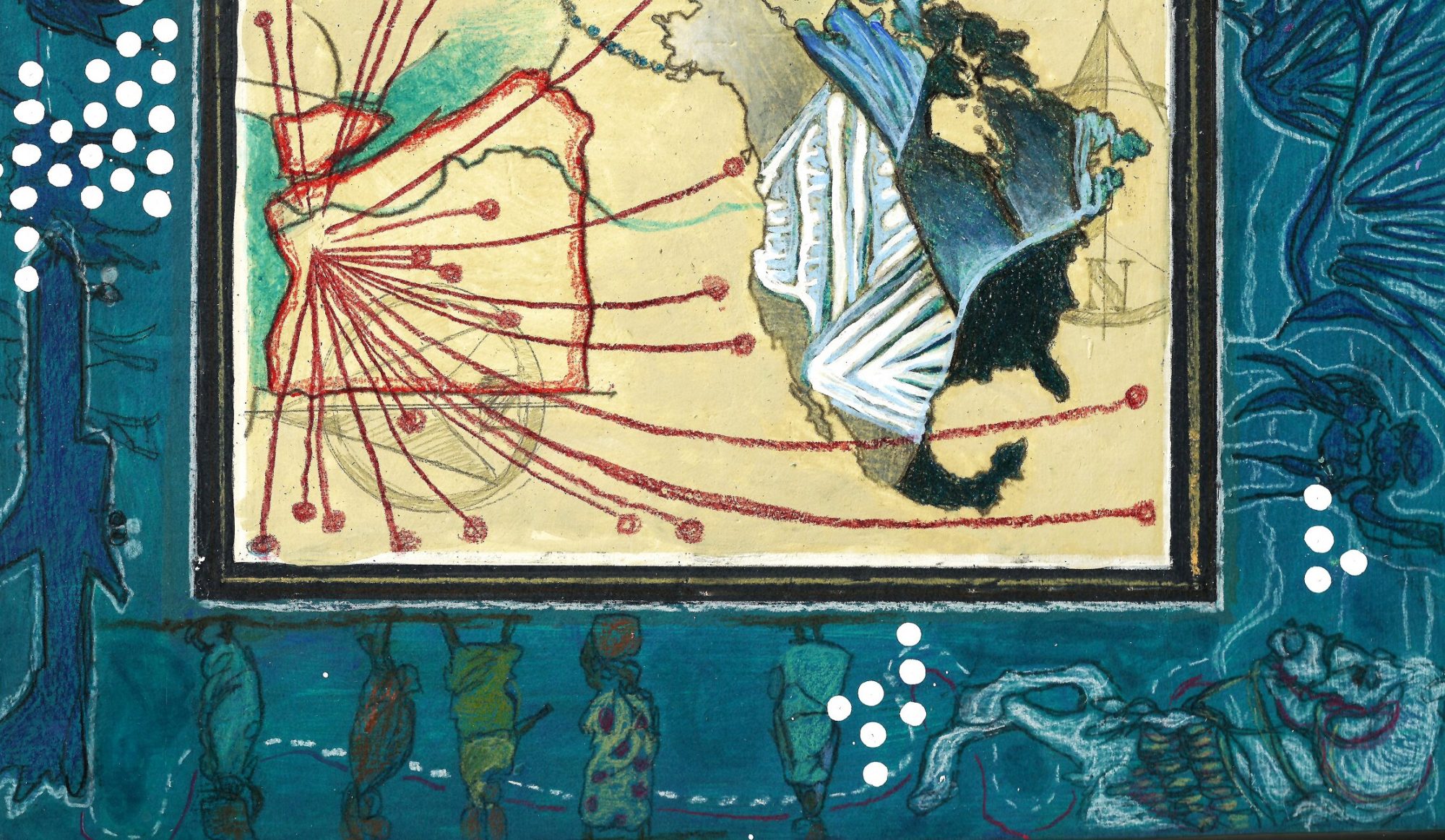The moon upon its fourteenth night
we only liberate ourselves by binding our liberations to those of one another
Home/Making at the Art Bank
I Am Not Asking For the Moon
Projections
PROJECTIONS
In cartography, a projection is a transformation of the three-dimensional shape of the planet onto a two-dimensional surface. Mapped projections, by definition, distort the surface to some extent: some of the most accurate projections are less legible due to the lines of division and intersection, whereas some of the most recognizable projections (such as the Mercator projection) distort large portions of the globe by shrinking equatorial regions in comparison to northern landmasses. In psychological terms, projection refers to the impulse to see aspects of oneself — accurately or inaccurately — in others.
In cartography, a projection is a transformation of the three-dimensional shape of the planet onto a two-dimensional surface. Mapped projections, by definition, distort the surface to some extent: some of the most accurate projections are less legible due to the lines of division and intersection, whereas some of the most recognizable projections (such as the Mercator projection) distort large portions of the globe by shrinking equatorial regions in comparison to northern landmasses. In psychological terms, projection refers to the impulse to see aspects of oneself — accurately or inaccurately — in others.
Between these two definitions of projection lay fertile grounds for considering the land through the lens of both the affective and the political. It underscores the impact of the epistemic violence of misrepresentation: the map becomes a way of understanding the non-Western world and racialized bodies, so that the ‘distorted’ map imposes just as real a set of political restrictions as the ‘accurate’ one.
As a point of departure, this project seeks to ask: How do racialized bodies navigate both geographic and social space? How are bodies codified as ‘excessive’ through normative conceptualizations of space and geography? And how is belonging asserted and denied through interactions with the land and its signifiers? By intervening upon images of the map, the border, and the earth, this project seeks to visualize the tension between belonging and rejection, expressing the effects of that tension through the use of animated images that cycle indefinitely and interact variously with the surfaces upon which they are projected. Dislocation — physical, social, and psychic — is made manifest in its different forms through animated work that is tactile and visceral despite its intangibility.
As a point of departure, this project seeks to ask: How do racialized bodies navigate both geographic and social space? How are bodies codified as ‘excessive’ through normative conceptualizations of space and geography? And how is belonging asserted and denied through interactions with the land and its signifiers? By intervening upon images of the map, the border, and the earth, this project seeks to visualize the tension between belonging and rejection, expressing the effects of that tension through the use of animated images that cycle indefinitely and interact variously with the surfaces upon which they are projected. Dislocation — physical, social, and psychic — is made manifest in its different forms through animated work that is tactile and visceral despite its intangibility.
Funding:
I gratefully acknowledge the financial support of the City of Ottawa, without which this project would not have been possible!
I gratefully acknowledge the financial support of the City of Ottawa, without which this project would not have been possible!
Work in progress (Undocumented: Pair of Shoes)
UNDOCUMENTED in (Chinatown) Remixed
UNDOCUMENTED is a series of paintings of specific artifacts from the Victoria & Albert Museum collections, more specifically, objects whose records and provenance documentation are missing or incomplete. Displaced from various places of origin, these objects have been re-organized in Western institutions in ill-fitting categories without social & historical context. UNDOCUMENTED stylistically references the miniature painting traditions of the Middle East and South Asia to elevate and re-situate these artifacts in contemporary social contexts outside the museum.
The specific information that is lost or erased from museum records is relevant, too: it is rare for the makers of typically gendered forms of production (such as pottery or embroidery) to be remembered, so the ‘Maker: Unknown’ field becomes a memorial of sorts to under-recognized art forms and all their unrecognized creators.
These paintings are currently being shown in Shiraz Food Market as part of (Chinatown) Remixed, an annual Ottawa art festival that places local artists’ work in community spaces. Shiraz is a particularly rich site of meaning for these de-contextualized and re-contextualized objects. Among the tea, dates, and nuts, they become again what they were once meant to be: objects that enact spirituality through their use and creation, objects that enable meditative creation through practiced forms of making.
These paintings will be shown until October 16th (at the earliest) Shiraz Grocery is at 725 Somerset street W.

Work in Progress
New Project- Earthenware
Created in conjunction with the Montreal Museum of Fine Art. Sneak peek here.
‘Earthenware’ is a a series of six short animations, each of which is inspired by a specific object in the Montreal Museum of Fine Art’s collections and archives. This project, as with much of my previous work, considers questions of collection and colonization, ‘High Art’ versus ‘craft’, and the links between the objects and the places in which they are produced. The animations are shown in three pairs: in each pair, one is based on an object from the European collections, and one from the Muslim world (primarily from Egypt, my own place of national origin).
Stills:












































































